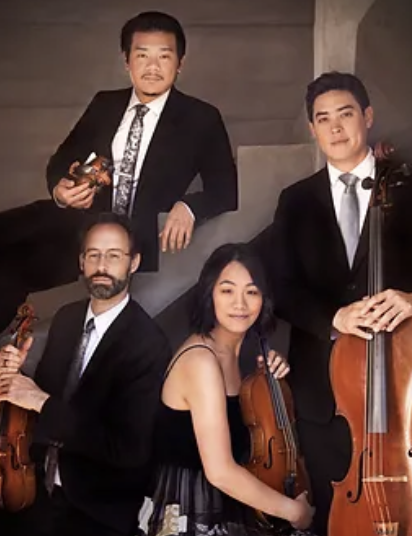|
Symphony
SRS SEASON ENDS WITH RESOUNDING TA-TA-TA-BANG
by Terry McNeill
Sunday, June 1, 2025
Symphony
YOUTHFUL VIRTUOSITY ON DISPLAY AT USO'S MAY CONCERTS
by Peter Lert
Saturday, May 17, 2025
Symphony
MYSTICAL PLANETS AND LIVELY GERSHWIN ORTIZ AT FINAL SRS CONCERT
by Peter Lert
Sunday, May 4, 2025
Symphony
VSO'S CONCERT MUSIC OF TIME, MUSIC OF PLACE
by Peter Lert
Sunday, April 27, 2025
Choral and Vocal
VOCAL ELEGANCE AND FIRE AT THE 222'S RECITAL APRIL 26
by Pamela Hicks Gailey
Saturday, April 26, 2025
CANTIAMO SONOMA SINGS AN INSPIRED GOOD FRIDAY MOZART REQUIEM CONCERT
by Pamela Hicks Gailey
Friday, April 18, 2025
DRAMATIC SHOSTAKOVICH SYMPHONY CLOSES PHILHARMONIC'S 25TH SEASON
by Terry McNeill
Sunday, April 13, 2025
LARGE COLLEGE OF MARIN AUDIENCE GREETS STOPHER ARTISTRY
by Terry McNeill
Saturday, April 5, 2025
Chamber
FRISSON DELIVERS SHIVERS OF DELIGHT
by Abby Wasserman
Sunday, March 30, 2025
OLD AND MOSTLY NEW IN SRS MARCH CONCERT IN WEILL
by Peter Lert
Saturday, March 22, 2025
|
 |
 Telegraph String Quartet |
A JOURNEY THROUGH MUSICAL TIME
by Abby Wasserman
Sunday, April 2, 2023
The Telegraph Quartet, resident quartet at the San Francisco Conservatory of Music, created a “Journey for the String Quartet” for Chamber Music Marin April 2 that put the expressive versatility of the form on full display.
Compositions by Haydn, Mendelssohn and Gabriela Frank were played with much innovation, showcasing the sonic range of the string instruments whose wonderful components can produce a universe of sound effects. Grand imitators of nature, they can sound like wind or rain, and can imitate birdsong, human voices and other orchestral instruments. They can knock, wheeze, whine, exclaim, screech, sing arias, and blend in four-part harmonies that make one want to cheer or weep.
Quartet members violinists Eric Chin and Joseph Malle, violist Pei-Ling Lin, and Jeremiah Shaw, cello, played with great verve, and the audience in the Mt. Tamalpais United Methodist Church audience responded with rapt attention.
The program opened with Haydn’s F Major Quartet, Op. 50, No. 5, one of six “Prussian” Quartets dedicated to the composer’s friend King Frederick William II of Prussia. Here was a fine example of Haydn’s contribution to the form, the first movement in sonata form, full of affecting sonorities, strong accents and four-voice harmony. Each of the four movements (allegro, adagio, minuet/trio, and vivace) hit a middle way between lyricism and elvish, with little musical teases here and there.
The F major is titled “The Dream,” and the adagio movement is dreamlike, with gently rocking string trills, the violins often ascending and viola and cello often descending. The third movement had an insouciant brightness, and the fourth featured trills, mordants and piquant ornaments, the music finally resolving with a brief but satisfying coda.
Gabriela Lena Frank (b. 1972) wrote her Leyendas: An Andean Walkabout, for string quartet in 2001, and she created a version for string orchestra in 2003. The strings imitated ancient panpipes, chalango guitar and other Andean instruments, the composer’s deliberate effort to suggest the spirits of past South American highlands civilizations. There were six parts, each distinct in mood, rhythm and imagery, each a miniature tone poem. The composition mixes western classical and Andean folk music traditions.
The first, Toyos, had a haunting medieval sound, imitating the breathy panpipe in parallel fourths or fifths; the second, Tarqueda, approximated the sound of the heavy wooden duct flute that splits the notes when overblown, like a rush of wind at Andean altitude, with rapid bow slashing and finally an eerie cello slide into stillness. The playing of Himno combined a panpipe effect with knocking and plucking. Chasqui was inspired by the ancient Incan communication runners. Canto de Velorio portrayed “la llorona,” a professional weeping woman who is a paid mourner at a funeral. A chorus of lloronas is suggested in this music, and the Catholic chant Dies Irae expresses the mix of the church’s and traditional Quechua rituals.
Leyendas closed with Coqueteos, a flirtatious love song. Close harmonies and the sounds of guitars strummed by romanceros, men who sing love songs, created a romantic and festive atmosphere.
Following intermission the Telegraph players were joined for the Mendelssohn Octet in E-flat Major, Op. 20, by conservatory graduate students Archie Brown and Po-Yu Lee, violins, Zoe Yost, viola, and Calvin Kung, cello. In this famous music the composer didn’t settle for doubling instrumental parts to add volume and richness, but wrote a separate part for each performer, making the Octet the first of its kind. It was interpreted brilliantly. In this performance the four movements seemed to be a life journey with pure instrumental poetry. Each player wove thematic threads into its colorful fabric. The eight musicians, each with their own part and their chance to shine, brought light, energy, collegial discipline and devotion to the music, with the culminating fugue in nine voices a sublime conclusion.
|

